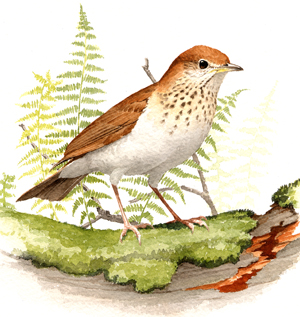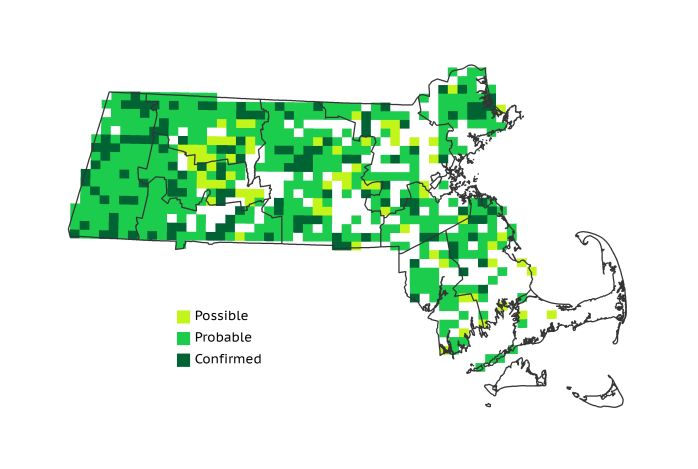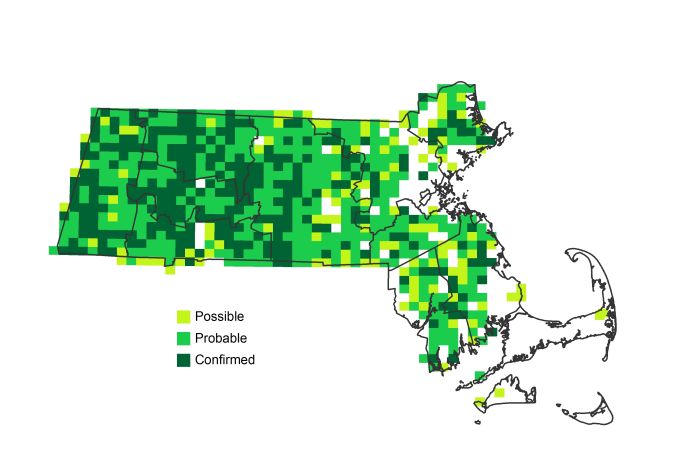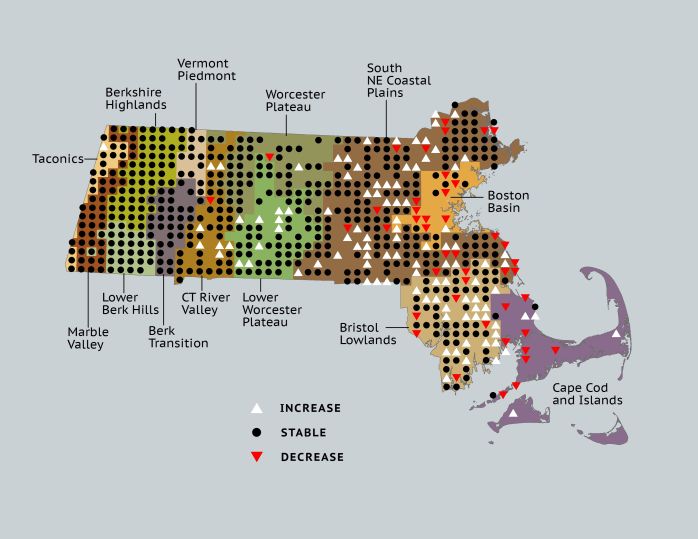Find a Bird
Veery
Catharus fuscescens

Very widespread and likely increasing
“The last of the light of the sun / That had died in the west / Still lived for one song more / In a thrush’s breast.” – Robert Frost, “Come In”
Veeries are counted among the so-called “spot-breasted thrushes,” which are known for their hauntingly beautiful songs and predilection for forest habitats. This species is more often heard than seen, and it will sometimes disappear into a tangle of briars if a human observer draws near. Veeries can be found in most deciduous or mixed forests with sufficient undergrowth, but they prefer moist woodlands and swamp forests.
Historic Status
Ornithologist Alexander Wilson discovered the Veery in 1831 and he named it Wilson’s Thrush (Wilson & Bonaparte 1831). As such, when William Peabody reported to the state legislature about the birds of Massachusetts at the end of the decade, he could only say that the species was not yet “sufficiently known,” but was described by Thomas Nuttall as “a common bird,” (Peabody 1839). In those days, the Veery resided in wet woods and in refuges from the vast open agricultural fields of the time. In the twentieth century, as forests regenerated, the amount of available breeding habitat increased and dramatically improved for the Veery.
Atlas 1 Distribution
Veeries were widespread in the state during Atlas 1, and were found in 63% of the state. They were particularly thick in the westernmost ecoregions, leaving only a small number of blocks unoccupied west of the Connecticut River Valley. The valley itself had 79% block occupancy, no doubt the result of the agrarian character of much of the land there. The Lower Worcester Plateau had birds in only 72% of its blocks, but the higher and more forested Worcester Plateau surpassed 87%. Block occupancy steadily declined moving eastward from there; though all regions had at least some Veeries, the Boston Basin had them in only 29% of blocks. The Cape and Islands had no Confirmed breeding records at all during the Atlas 1 period, and Veeries were recorded in only 10% of the region.
Atlas 2 Distribution and Change
The other-worldly, flutelike song of the Veery was heard even more widely in the Commonwealth during Atlas 2 than it was in Atlas 1, and overall it increased to 73% block occupancy, with a net gain in its footprint of 7% of the state. In Atlas 2 the species reached near saturation in block occupancy from the western regions of the state all the way to the Coastal Plains. It was only in the habitat-poor Boston Basin and Cape and Islands regions where the species dropped below 70% block occupancy. The Veery persisted and increased in all regions except these two, where there was a net loss in the percent of blocks occupied.
Atlas 1 Map

Atlas 2 Map

Atlas Change Map

Ecoregion Data
Atlas 1 | Atlas 2 | Change | ||||||
Ecoregion | # Blocks | % Blocks | % of Range | # Blocks | % Blocks | % of Range | Change in # Blocks | Change in % Blocks |
Taconic Mountains | 14 | 87.5 | 2.3 | 24 | 96.0 | 3.2 | 1 | 6.7 |
Marble Valleys/Housatonic Valley | 39 | 100.0 | 6.4 | 39 | 100.0 | 5.2 | 0 | 0.0 |
Berkshire Highlands | 54 | 98.2 | 8.8 | 55 | 100.0 | 7.3 | 0 | 0.0 |
Lower Berkshire Hills | 28 | 100.0 | 4.6 | 31 | 100.0 | 4.1 | 0 | 0.0 |
Vermont Piedmont | 16 | 94.1 | 2.6 | 17 | 100.0 | 2.2 | 0 | 0.0 |
Berkshire Transition | 35 | 92.1 | 5.7 | 40 | 100.0 | 5.3 | 0 | 0.0 |
Connecticut River Valley | 44 | 78.6 | 7.2 | 58 | 89.2 | 7.7 | 6 | 12.5 |
Worcester Plateau | 68 | 87.2 | 11.1 | 86 | 97.7 | 11.4 | 1 | 2.1 |
Lower Worcester Plateau | 53 | 71.6 | 8.7 | 80 | 100.0 | 10.6 | 8 | 14.8 |
S. New England Coastal Plains and Hills | 174 | 64.4 | 28.4 | 226 | 79.9 | 29.9 | 32 | 14.2 |
Boston Basin | 16 | 28.6 | 2.6 | 12 | 21.4 | 1.6 | -4 | -7.3 |
Bristol and Narragansett Lowlands | 57 | 53.8 | 9.3 | 80 | 70.2 | 10.6 | 21 | 20.8 |
Cape Cod and Islands | 14 | 10.3 | 2.3 | 9 | 6.3 | 1.2 | -5 | -4.2 |
Statewide Total | 612 | 63.2 | 100.0 | 757 | 73.0 | 100.0 | 60 | 7.2 |
Notes
The Veery shows a significant decreasing Breeding Bird Survey (BBS) trend in Massachusetts and in the Eastern US overall. The decline noted in the BBS is of interest, as it is at odds with the Massachusetts BBA2 results. Though they remain as widespread as ever, Veeries are less numerous, and fall into our “whispering bird” category – those with a demonstrated stable or increasing footprint but also a demonstrated decline in abundance.



